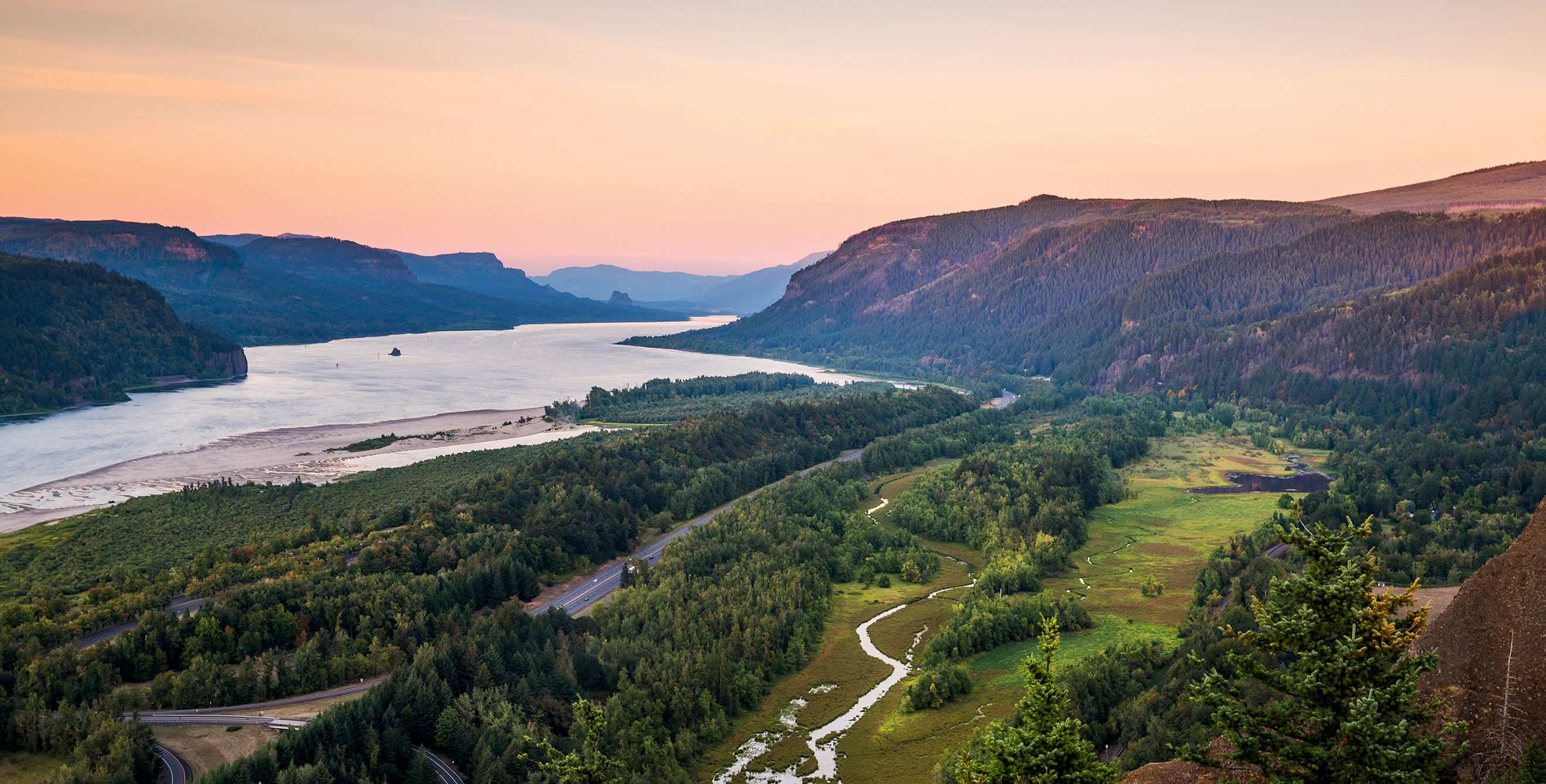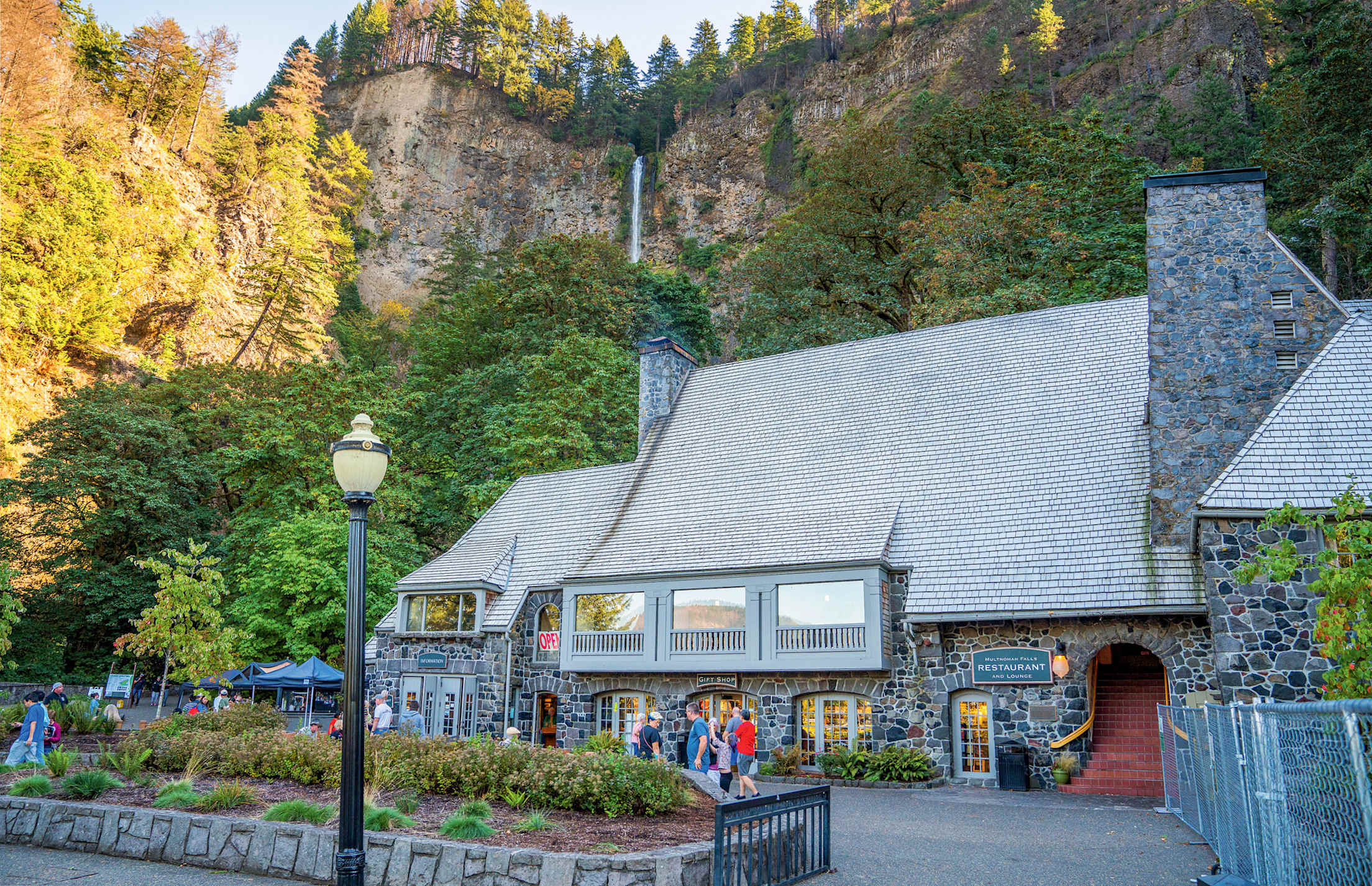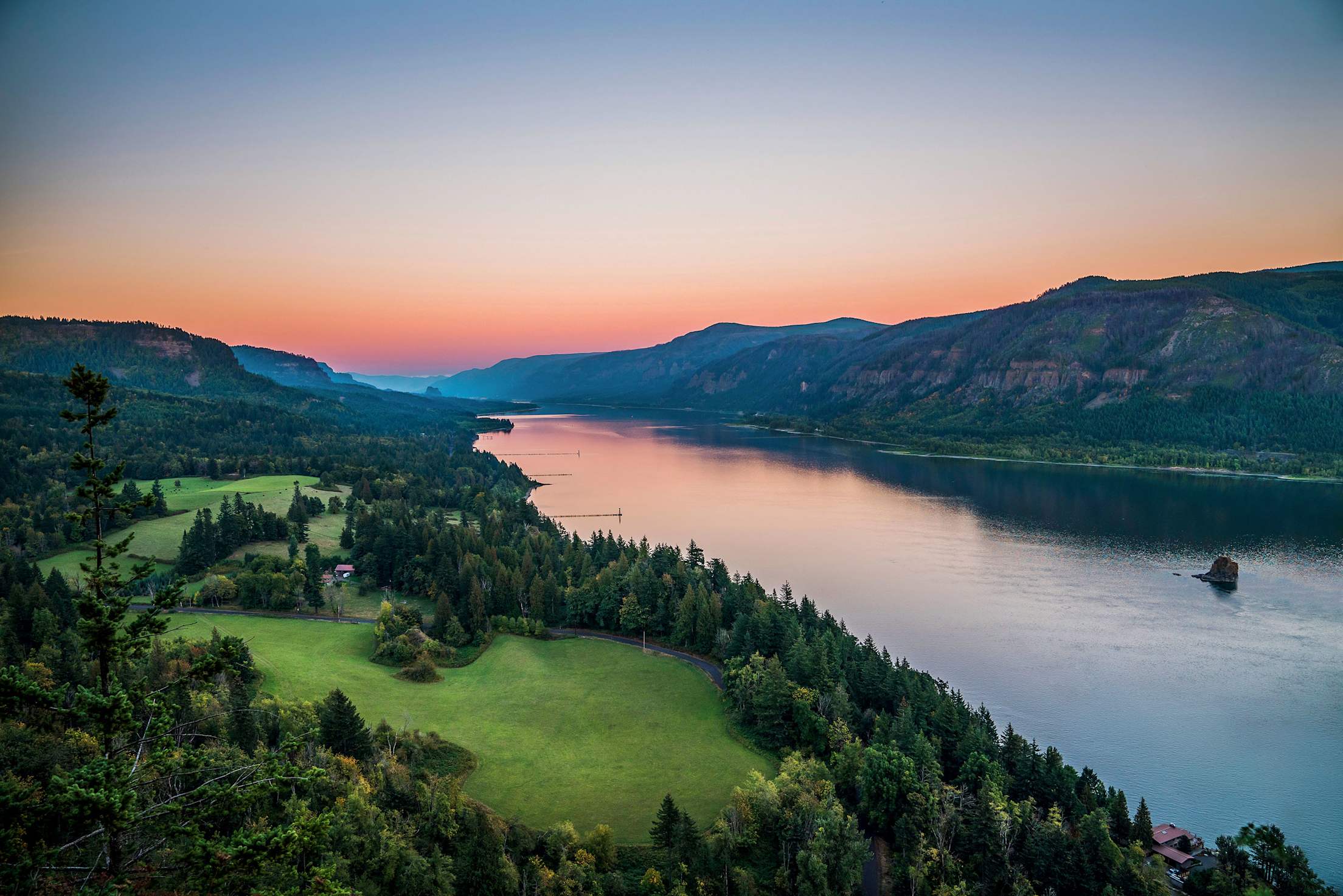
Rediscovering Columbia River Gorge After Eagle Creek Fire
As the Columbia Gorge heals from the Eagle Creek Fire, visitors rediscover a resilient landscape.

For decades, the Columbia River Gorge was my safety valve. From my home in Portland, I could drive 45 minutes east to Multnomah Falls and stare at that delicate foamy braid of water until I remembered that nature is bigger than we are. Or I could bicycle out along the Historic Columbia River Highway and, swooping downhill on that shaded, sinuous road, feel like a bird in the forest.
Now, though, the gorge is limping its way back from a severe burn. In September 2017, a teenager playing with fireworks ignited a blaze that ultimately spread across 50,000 acres and destroyed at least four structures. A six-mile stretch of the historic highway, closed for 14 months, has reopened. But the denuded slopes above it have lost the vegetation that once kept their topsoil in place; rocks and gravel often spill down onto the road, especially during rainstorms.
As I write this, some of the gorge's most popular hiking routes, including the beloved Eagle Creek Trail east of Multnomah Falls, are still closed. At the waterfall itself, the fire cut off access to one large parking lot. Competition for the remaining spaces has grown so fierce that frustrated motorists sometimes ram the metal gate guarding the lot.
I must admit that, when the anonymous teen was ordered by the court in February 2018 to pay $37 million in restitution, an ugly, spiteful part of me rejoiced. (Of course, he'll never actually have to pay that much.) But I've moved on since then. I've had to acknowledge that the blaze can be blamed in part on U.S. Forest Service policies that turned the forests of the West into overgrown tinderboxes. I've had to admit that, even before the fire broke out, the gorge itself was already a little overloved, a little too crazy with crowds. I've come to focus less on anger and retribution and more on figuring out how our relationship to the gorge needs to change.

Multnomah Falls appears unmarred by fire.
It helps to look at the 2017 conflagration in a broader scope of time. Which is why I headed into the woods with Lisa Ellsworth, a fire ecologist at Oregon State University. On a warm morning in August 2018, we hike along the Pacific Crest Trail outside Cascade Locks, Oregon, a few miles east of Eagle Creek. Trees all around us have burned trunks. Scorched limbs dot the forest floor; among them, new ferns are flourishing, even in the dry depths of an August drought. Ellsworth exults over one clump. "They're looking good," she says, "and these snags"—she gestures to some charred, dead, branchless but still-standing trees nearby—"they'll provide a good home for woodpeckers and flycatchers. After that, you'll get secondary cavity dwellers— songbirds, small mammals. Debris is coming down off the slopes, sure, but erosional processes created the gorge. They were here long before humans came and messed with the system. And when debris washes into the streams, it'll be good for salmon."
A former wildland firefighter, Ellsworth has studied fires for two decades and sees nothing unusual about the one that swept through the gorge. Indeed, when it comes to describing the fire's impact on the forest, she takes umbrage at the extreme labels it's been given—devastating, catastrophic.
For the woods, the fire was a routine and necessary event. It was the forest purifying itself. "The fire burned the ladder fuels here," she tells me, explaining that no fallen limbs are left to carry tree-killing flames up to the crown of the forest. "We won't have to worry about another fire right here for a long time."
While no adult living now will ever see the gorge as thickly forested as it was in 2016, the fire killed less than 15 percent of the canopy within the burn area, and the most severe burning happened primarily at higher elevations. (Fire tends to travel up ridgelines.) "It would be nice to get people out here to see that the forest isn't all burned up," Ellsworth says. "We have to change public perception."
So far, few people have ventured deep into the forest to see the burn up close. Ellsworth and I cross paths with just a handful of long-distance backpackers on the Pacific Crest Trail. It feels like we're in on a secret, beholding the new life and beauty that abide in a burned forest. We reach Dry Creek Falls, two miles from the road, and then walk back mostly in silence, admiring a patch of purple fireweed that has sprouted in the scorched soil, then a tree that gave up all its lower branches to the flames. Its crown is still green. "That tree has protected itself from the next fire," Ellsworth marvels. "It's got resilience."

Signs of fire persist in this patch of woods near the Historic Columbia River Highway.
Managing Multitudes
A few days later, I visit Multnomah Falls and watch as the water plunges from the fir-dotted butte of Larch Mountain into a black pool, then descends again, the plume thicker now, roaring, into a wider, shallower pool beneath that. Several tour buses' worth of other visitors watch with me, laughing, shooting videos, updating their Instagram feeds.
Nearly 2 million people visit these falls every year, and they come—everyone from Grandma to the local Cub Scout pack—for a reason so deep that it can scarcely be articulated: The falls puts us in communion with the wild Northwest. Turn the corner on the walkway from the parking lot, and the great gush is right there before you, churning down the cliff, feeding some primal thirst you never quite knew existed.
Everything about the waterfall experience is set up to immerse you in ruggedness—the stone bench on the observation deck, the steep paved paths to the upper falls, the concrete Benson Bridge that suspends you just above the cascade of the lower falls. Even the Multnomah Falls Lodge, built in 1925, has a rustic vibe. It's wrought of local stone, and the dining room is appointed with six looming 1930s-era photos of old-growth forests, returned to the wall after extensive smoke damage closed the lodge for three months. As I eat lunch with Rick Buck, the restaurant's concessionaire, I ask him if he plans to change anything about the lodge, postfire.
"Change?" Buck asks, incredulous.
It's true: The allure of the gorge is so basic that it would be stupid to change up the product. But something does need to be done about the ways we interact with this wonderland. Over the past 20 years, as Portland has attracted tens of thousands of outdoorsy transplants as well as legions of tourists, some gorge hiking trails have become traffic jams. Driving I-84, which cuts along the south bank of the Columbia River, is at times a tense, Mad Max experience.

Firefighters took a stand at the Multnomah Falls Lodge, dousing the building as the flames approached.
It's still not clear how the gorge can be managed to handle the multitudes, but the Oregon Department of Transportation is trying. Connecting existing paved corridors, the agency has pieced together most of a 73-mile-long bike route stretching east from Troutdale, a Portland suburb, to The Dalles. Even before the fires, the state began running a bus line that makes several daily trips up the gorge, with stops at Rooster Rock State Park (a swimming-friendly venue on the river), Multnomah Falls, and Cascade Locks.
Heading home from Multnomah Falls, I take that bus myself. It's air-conditioned and cool. I gaze out the window and watch the Columbia meander between the green trees on its shores.
In the hills all around me, volunteers are laboring to bring back the gorge's trails. Last year, a group called Trailkeepers of Oregon conducted more than 170 work parties in the gorge, involving 1,500 people. Since the fire, the nonprofit has helped open up over 60 miles of trails, including one to Angels Rest, a cragged lookout looming 1,500 feet over the river. The campaign has at times been almost overwhelming. Steve Kruger, the Trailkeepers' executive director laments, "Every time we step onto the Larch Mountain Trail, we see new fallen rocks to clear. These trails are going to require maintenance and care for quite some time."
In November, the whole 6.8-mile length of the Larch Mountain Trail reopened, albeit with signs warning of rock slides. "There's certainly an increased likelihood of slides in the more fire-affected areas," trail crew leader Josh Durham tells me, "but the gorge was always a dynamic environment, even before the fire."

Watching the sun set over the Columbia River, you'd be forgiven for forgetting the devastation wrought by the fire.
The Long View
Like many Oregonians, I have magnetized photos of the Columbia Gorge on my fridge: Dog Mountain abloom with the wildflowers of spring, giant old-growth firs along the Eagle Creek Trail bathed in a heavenly morning light. Each image captures a single moment in time. But we're all learning that the gorge is a movie that's unspooling its dramas—a fire here, a fallen tree there, another one taking root in the rich soil—very, very slowly.
The Eagle Creek Fire invites us to see that the wild places we love are at once dynamic and fragile, and that if we want to keep enjoying them, we'll need to fit ourselves more gently into nature's pattern. We aren't there yet. Motorists keep running into the gate at Multnomah Falls.
Trailkeepers' Steve Kruger is working to alleviate the pressure on the gorge's most popular attractions. "There are spectacular sights in every corner of the gorge," Kruger says. "It behooves people to do some research and find little-known places like Falls Creek Falls, on the Washington side."
One morning I take Kruger's advice and make my first foray out to that cascade. It's a three-tiered gem that drops into a still pool rimmed with vivid moss-covered rocks.
The hike to it is a gentle two miles long, and as I walk, I keep thinking of the great Northwest writer Raymond Carver. His last collection of poems was called A New Path to the Waterfall. Carver was in his late 40s when he wrote the book, dying of lung cancer, but even in his darkest hour, he was able to see life as shining, blossoming on. "I've always wanted brook trout / for breakfast," Carver wrote. "Suddenly I find a new path / to the waterfall."
In the ashes of the gorge fire, we need to look for some of that same saving hope.